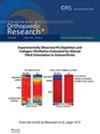Effect of patient specificity on predicting knee cartilage degeneration in obese adults: Musculoskeletal finite-element modeling of data from the CAROT trial
Abstract
Obesity is a known risk factor for development of osteoarthritis (OA). Numerical tools like finite-element (FE) models combined with degenerative algorithms have been developed to understand the interplay between OA and obesity. In this study, we aimed to predict knee cartilage degeneration in a cohort of obese adults to investigate the importance of patient-specific information on degeneration predictions. We used a validated FE modeling approach and three different age-dependent functions (step-wise, exponential, and linear) to simulate cartilage degradation under overloading in the knee joint. Gait motion analysis and magnetic resonance imaging data from 115 obese individuals with knee OA were used for musculoskeletal and FE modeling. Cartilage degeneration predictions were contrasted with Kellgren–Lawrence (KL) and Boston–Leeds Osteoarthritis Knee Score (BLOKS) grades. The findings show that overall, the similarities between numerical predictions and clinical measures were better for the medial (average area under the curve (AUC) = 0.62) compared to the lateral compartment (average AUC = 0.52) of the knee. Classification results for KL grades, full patient-specific models and patient-specific geometry with generic gait data showed higher AUC values (AUC = 0.71 and AUC = 0.68, respectively) compared to generic geometry and patient-specific gait (AUC = 0.48). For BLOKS grades, AUC values for both full patient-specific models and for patient-specific geometry with generic gait locomotion were higher (AUC = 0.66 and AUC = 0.64, respectively) compared to when the generic geometry and patient-specific gait were used (AUC = 0.53). In summary, our study highlights the importance of considering individual information in knee OA prediction. Nevertheless, our findings suggest that personalized gait play a smaller role in the OA prediction and classification capacity than personalized joint geometry.

 求助内容:
求助内容: 应助结果提醒方式:
应助结果提醒方式:


